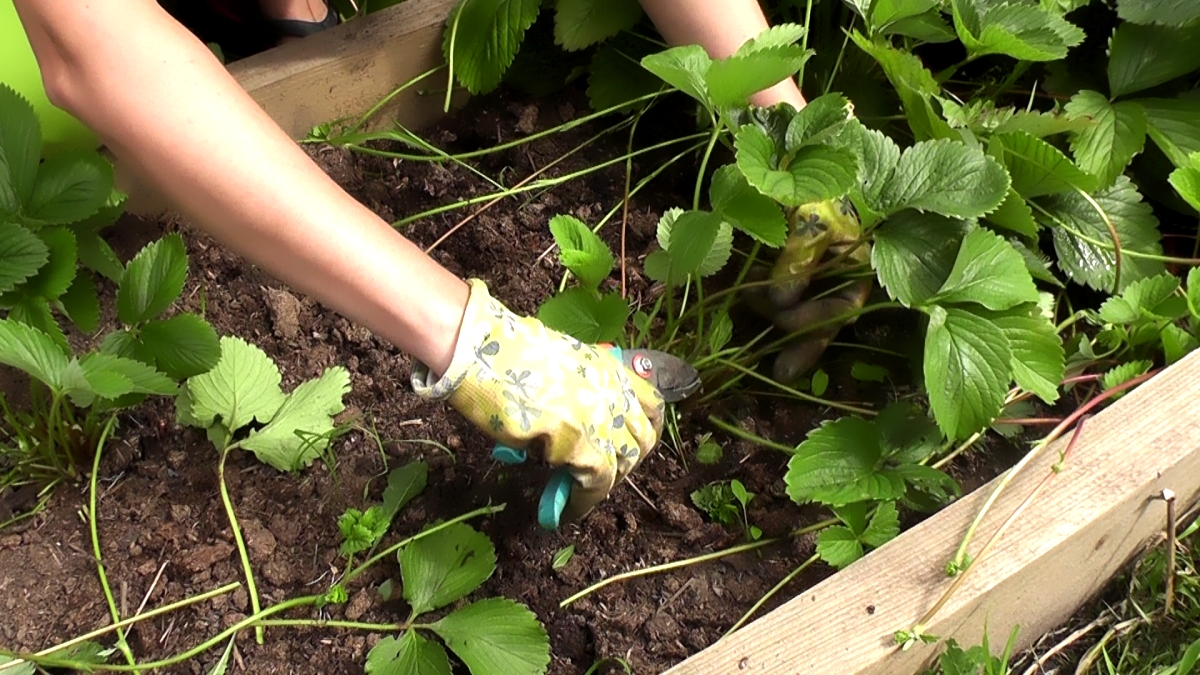
Pruning is one of the must-have items for strawberry care. This simple procedure will help to get even larger and sweeter berries in the next season.
Content
- 1 Why trim your mustache?
- 2 Why and how to mow strawberries in the summer?
- 3 When to cut strawberries?
- 4 How to feed strawberries after pruning
- 5 How to care for strawberries after fruiting
- 6 Watering strawberries after harvest
- 7 Strawberry care in the spring. Tips of Oktyabrina Ganichkina
- 8 Autumn care for the maintenance of strawberries
- 9 How to care for strawberries after planting in the fall
- 10 Pest treatment
- 11 Disease prevention
- 12 Advice
Why trim your mustache?
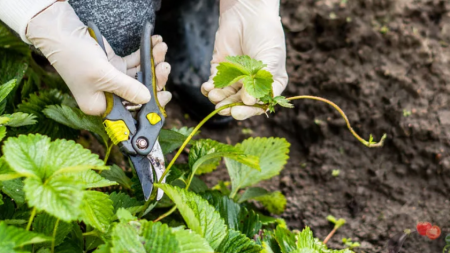
The formation of antennae in strawberries is an absolutely normal process. So the plant multiplies. But if there is no problem to grow strawberry seedlings, then it is necessary to prune them.
Although for the reproduction of berries, not all antennae are needed. The most powerful are the first ones that the mother bush released. They can be rooted, and all the rest will not give full-fledged offspring, therefore they should also be removed.
The tendrils take a lot of power from the plant, and only timely pruning can preserve the potential of strawberries. If you do not remove them, every year the beds will become more neglected, and the berries are small and tasteless.
Why and how to mow strawberries in the summer?
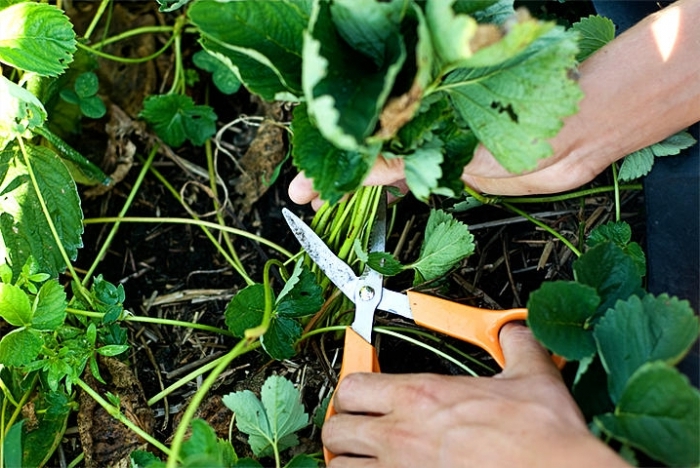
For large plantations, mowing strawberry bushes after fruiting should be the norm. This will not only save time and effort in removing the antennae and old leaves, but also prevent the development of fungal diseases, provide adequate ventilation of the beds and help the roots accumulate strength for the new season.
Best results are obtained by mowing strawberries 3-4 years old. This has a rejuvenating effect and guarantees an excellent harvest for the next year. But it’s better not to mow the young bushes, but to trim them carefully.
To do this, use secateurs or sharp scissors. Be sure to treat them before use in a solution of potassium permanganate. It is strictly forbidden to tear off leaves and antennae with your hands. So there is a risk to remove not only the aerial part, but also damage the root.
When to cut strawberries?
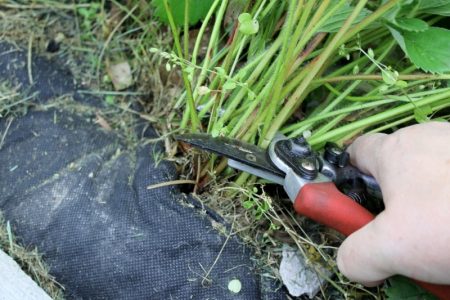
The procedure is carried out 5-10 days after the last harvest. Most often this happens before July 20, but a lot depends on the variety, weather conditions and other factors. You can understand that the time has come to do this by the appearance of new young greenery on the bushes. Often it is necessary to carry out it again, up to 3-4 times per season, because the antennae continues to grow, and the leaves grow old.
If you mow the beds with strawberries, re-pruning is not necessary.
The day before this, it is necessary to water the beds with strawberries well. It is necessary to mow with a very sharp oblique and not under the root, but leaving the stems to a height of about 3 cm.
If the bush is sick or weak, pruning should be done as soon as possible. It is permissible to carry out the procedure on the second third day after harvesting and preferably as close to the ground as possible to remove possible fungal spores.
It is very important to remove not only aged but also damaged leaves. The first pruning is carried out on 3-10 days after harvesting, and the last immediately before shelter for the winter.
Do not put off pruning strawberries. It is necessary that before the onset of cold weather young leaves have time to grow. Naked bushes may not tolerate colds and strawberries will die.
Time spending
To make strawberries easier to bear stress after removing the antennae and old leaves, you need to carry out the procedure at the most suitable time for this. Optimal if the day is overcast. Then pruning can be done at any time of the day, but if there is heat, it is better to do it in the evening, two hours after watering. After heavy rain, also cut off the antennae and leaves is not worth it.
How to feed strawberries after pruning
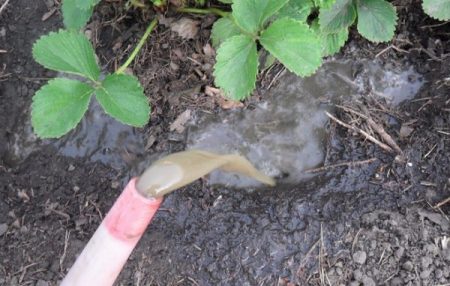
Traditionally, strawberry is recommended to use the Elegy mineral preparations, but organics also give excellent results. After harvesting, it is optimal to use freshly mowed siderates, solutions of litter or manure. Mulching with peat or Christmas needles gives a good result when laying young flower buds.
You can feed the berry with ammonium nitrate. Just remember that the excessive presence of nitrogen in the soil will lead to lush foliage growth, but the quality of the berries will decrease.
In general, according to the rules of agricultural technology, after trimming strawberries, it must be fed three times. For the first time, nitrogen is used, which stimulates young foliage to grow. After 14 days, fertilizing with potassium-phosphorus fertilizers is carried out, which will help lay flower buds. And around mid-September, mullein or other organic matter is used to water the beds.
To make the mullein solution more useful, add a glass of wood ash (10 liters of water) into it.
When fertilizing strawberries, you need to act on the principle that it is better not to overfeed than to overfeed.
How to care for strawberries after fruiting
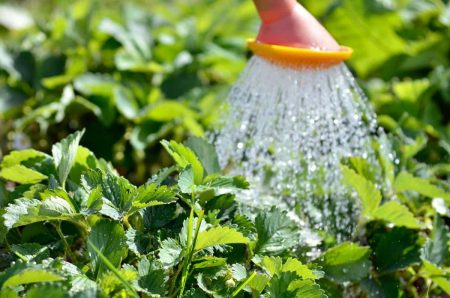
After harvesting strawberries, it is very important to maintain soil moisture.
It is good if before watering it turns out to dig a small trench around each bush so that the water gets to the roots faster. But if there is no time, at least loosen the soil a few hours after moistening.
For top dressing, you can cook "slurry." To do this, any weed grass (best of all nettles, hops, etc.) is laid on a third of the barrel, poured to the top with water and placed in a sunny place before fermentation. To speed up the process, you can add a little yeast.
Pour 0.5-1 liters under each bush, depending on the age of the strawberries. The remaining grass can be laid out between the rows.
After July Harvesting Strawberries
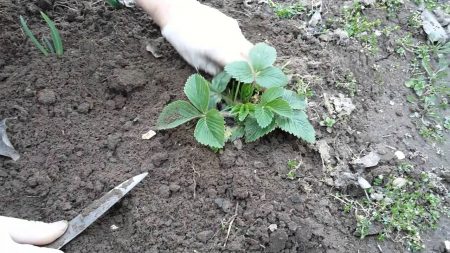
In July, most strawberry varieties cease to bear fruit, therefore, the main work is carried out precisely in this period.
To make the bush easier to tolerate pruning, it will not hurt to pre-feed it. Per square meter, a mixture of potassium chloride (20 g), ammonium nitrate (30 g) and superphosphate (50 g) should be added. The soil along with fertilizers must be well loosened to a depth of about 10 cm and slightly moistened.
Loosen the ground carefully so as not to damage the roots, which are located almost on the surface. After fertilizing, it is imperative to sprinkle the bushes with soil so that the subordinate roots are carefully covered.
In 5-7 days after pruning, when new young leaves begin to grow, it will be necessary to re-fertilize using a solution from a bucket of water 2 tablespoons. tablespoons nitrofoski and a glass of wood ash. It is necessary to water for each plant a liter and a half, depending on the age of the strawberry bushes.
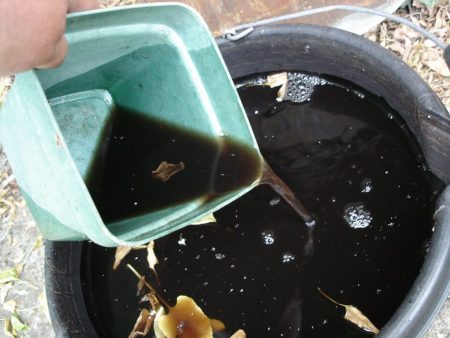
After a week, you can feed strawberries with chicken manure solution. It is diluted with water in proportions of 1:20 and watered under the root. 10 liters of solution is enough for 10 adult bushes and 20-25 young ones. For top dressing to give the best effect, you must first moisten the beds.
Mineral top dressing gives excellent results. To do this, you need to purchase a product specifically designed for strawberries, dissolve it in accordance with the instructions and process the bushes. Amofoska is considered universal. It contains not only potassium, nitrogen and phosphorus, but also sulfur, magnesium and calcium.
Fertilizers should not contain chlorine. His strawberries cannot stand.
In addition to mineral top dressing, humus can be used. Strawberry always reacts positively to it. Compost is simply brought into a hole dug around a bush. Peat is necessarily mulched from above.
Post-August Strawberry Care
The last summer month is dry and hot in the afternoon, so watering comes to the fore. It must be carried out at least twice a week. Sometimes there is a need to do this more often. To determine that the plant does not have enough moisture, you can use the drooping leaves.
Watering is carried out under the root or on the principle of sprinkling.
If the leaves continue to turn yellow and dry, they must be cut.
Feeding continues in August. For this, a solution of bird droppings (1:20 with water) or mullein (1:15 with water) is used. A 10-liter bucket should be enough for 10-15 bushes. If there is a need to transplant old bushes or plant new ones, this should also be done at the end of August so that the plants can take root.
September Care
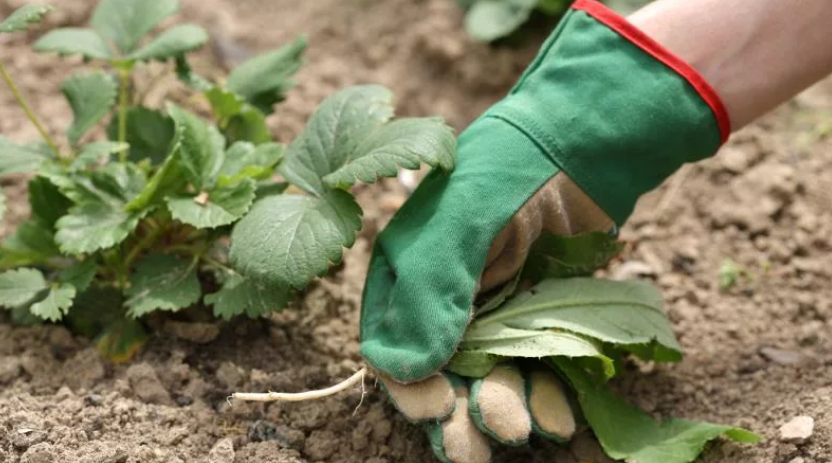
In September, flowers begin to form on some types of strawberries. The berries will not have time to ripen, so the plant will simply waste its energy. Therefore, it is necessary to break off the color and continue to remove the antennae and old leaves.
Before the onset of cold weather, strawberries must be fed. To do this, you can use a solution of chicken manure, which will provide additional heat during wintering. It does not hurt to dust the beds with wood ash. Be sure to inspect the bushes by removing yellowed leaves and plants that did not take root after transplantation.
Watering strawberries after harvest
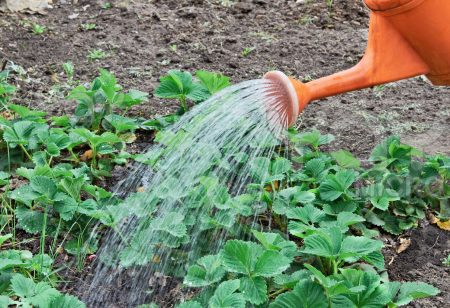
It is advisable to water it even more often than before picking berries. In order for moisture to remain longer in the ground and reach the roots in sufficient quantities, it is necessary to regularly loosen the soil around the bushes and mulch.
The frequency of watering in each case is individual. The soil on the bed should be always moist! A dry earthen lump should not form. But a clear schedule does not exist. There are only recommendations. You need to focus on the weather. If it rains, there is no need for watering. If there is heat, then it must be carried out at least once a week. On average, 2-3 buckets of water are consumed per square meter.
Use for irrigation should be well-maintained and heated for a day water.
The most suitable option for strawberries is drip irrigation. Indeed, with this method, the soil will always be sufficiently moistened. You can use plastic bottles for this. They just need to cut the bottom, dig them “shoulders” into the ground and fill them with water. Use any volumes, but it is more profitable to take five- or even ten-liter ones. They will need to be filled much less frequently than bottles of 1.5-2 liters.
You can create a drip irrigation system from hoses. They are laid out along the beds, holes are made in the necessary places and connected to a source of water supply. It may be a water supply, but it is better to install a large barrel on a small elevation and fill it with water. So she will be able to heat up. But when choosing this option, you must take care of the filter, which will protect the drip irrigation system from leaves, pebbles and other small debris.
Strawberry care in the spring. Tips of Oktyabrina Ganichkina
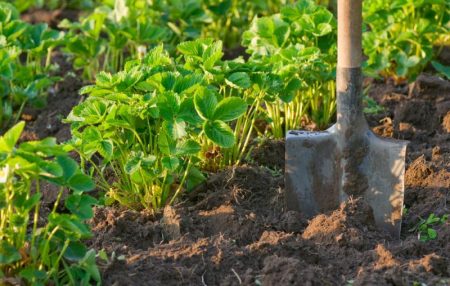
In terms of strawberry cultivation, Oktyabrina Ganichkina places particular emphasis on spring planting care. As soon as the frosts end, you need to remove the artificial shelter from it, carefully remove the foliage or other natural "blanket" to the side. So young sprouts will develop well. Watering is not necessary, at first strawberries are more than enough soil moisture.
But processing from pests does not hurt.The most proven method is dusting with wood ash. This will scare off dangerous insects, and provide additional top dressing to the bushes.
After 2 weeks, you can feed the solution of bird droppings (1:20) or mullein (1:15).
After another week, you can start watering. While it is not too hot, it is enough to do this once every 10-14 days, then the procedure will need to be carried out 2 times a week.
Be sure to regularly weed and loosen the soil, as well as mulch the beds. Oktyabrina Ganichkina advises to lay peeling potatoes, carrots and other vegetables between strawberry bushes. She claims that this will help enrich the soil with additional nutrients, as well as retain a sufficient amount of moisture in it.
Autumn care for the maintenance of strawberries
Removable strawberries bear fruit several times during the season, so caring for it is different from usual. Trimming work begins around the beginning and middle of September. Mowing is not recommended, because before the cold weather new foliage will not have time to grow. It is necessary to trim with sharp scissors or secateurs and antennae, and old or diseased leaves. Before this, you need to slightly moisten the soil, but if the nights are already cold, then it is better to do it during the day.
Removal of antennae and weeding on the strawberry remontant should be carried out throughout the growing season.
After the procedure, it is necessary to loosen the soil, mulch with straw, hay, fallen leaves or freshly cut siderats.
It is not possible to feed repair strawberries unlike ordinary varieties three times, therefore, it is optimal to use complex fertilizers that contain all the necessary nutrients needed by the plant for wintering and full development for the next season.
Post-Harvest Victoria Care
Victoria finishes fruiting in late August and early September. Care for it is the correct formation of bushes. They are compact in Victoria and should not grow, otherwise it will negatively affect the quality of the fruits.
How to care for strawberries after planting in the fall
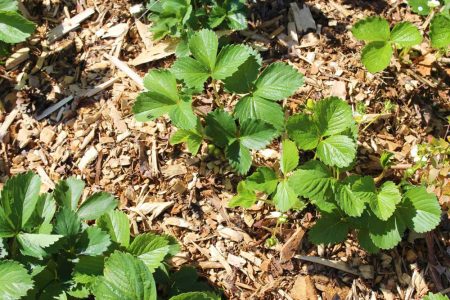
After planting strawberries in autumn, the beds are mulched with peat, sawdust, straw or freshly cut siderata.
More strawberries will not require any intervention until wintering. It will only be necessary to water it once a week, while it is hot, and two weeks before shelter, feed it with a solution of charcoal (a glass in a bucket of water) or bird droppings (1:15 with water).
Before the onset of cold weather, you need to loosen the soil between the rows, carefully examine the bushes for damaged, sick and weakened leaves, you also need to pay attention to the possible presence of pests. They often spend the winter in the warm shelter that is created around the strawberries. To scare them away, you can use special tools or simply spread onion and garlic husks along the aisles, dusting with wood ash.
Strawberry Shelter for the Winter
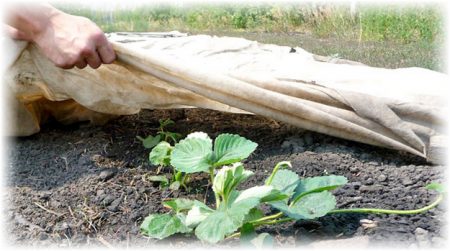
It is a must to cover young strawberries for the winter! It is not yet so strong that it can endure frosts without additional help.
For shelter, you can use agrofiber, ordinary pieces of cloth, old blankets, etc. Reliably protect fallen leaves or straw from the cold. But the natural shelter must be additionally fixed so that it is not blown away by gusts of wind. For this, the stalks or thinly cut tree branches remaining after growing the corn are excellent. They are laid out along the aisles.
The first option is more acceptable, because with the help of artificial shelter, while the cold is just beginning, at night the beds can be covered and opened during the day. So the bushes will be more hardened. With a natural “blanket” you won’t do that.
Pest treatment
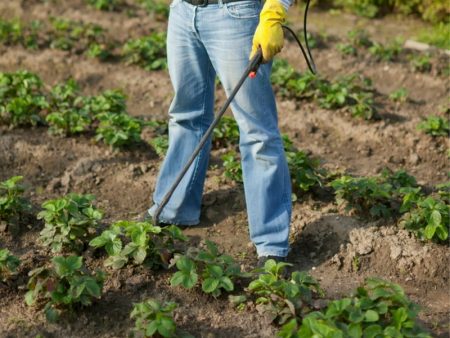
You can process strawberries from pests either in early spring or after fruiting.During flowering and fruiting, this is dangerous.
After pruning, strawberries should be treated with a solution of potassium permanganate light pink. This helps to decontaminate the places of cuts and the remaining sprouts, as well as the soil around the bushes.
One of the frequently attacking strawberry beds of pests is the weevil. To protect against it, the drug Intavir is used. Processing should be carried out twice, once every 14 days. It is also used to kill the insect. With lesions, the solution is applied once a week.
It helps to drive away pests from strawberries iodine solution (10 drops per bucket of water). Spraying is carried out every 10-14 days.
For the treatment of large plantations, it is recommended to use wide-acting insecticides (Kemifos, Actellik, etc.).
Before processing from pests, it is necessary to weed and loosen the beds.
Disease prevention
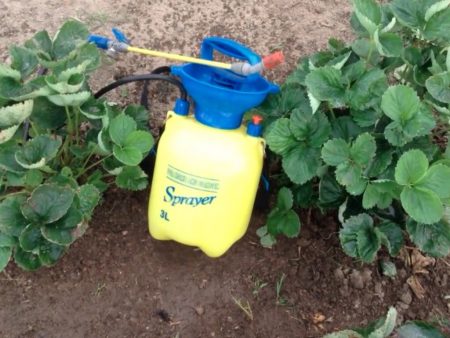
Strawberries suffer from fungal diseases. Pathogenic spores are carried both with the wind, and with the tools used to work, and even with drops of water during irrigation or during rain.
Contributes to the development of diseases, increased humidity, thickening of plantings, placement of beds in the lowlands, as well as excessive amounts of nitrogen during feeding.
Biological products Fitosporin or Fitoplus help protect strawberries from rot.
To protect the berries from decay, it is necessary to pluck them from the bushes in a timely manner, preventing them from overriding.
A novelty is the drug Zircon. It is used for foliar treatment. It is absorbed into the leaf and helps the plant activate its own forces to resist diseases and viruses.
A proven tool for years is Bordeaux fluid. A solution from a teaspoon of 500 ml of water is sprayed with plantings before flowering, after harvesting and after mowing or pruning.
It is necessary to regularly inspect strawberry beds, timely removing the affected leaves or plants, if it is too late to take measures.
One of the folk remedies for combating diseases and pests is planting next to the berries of marigold, garlic and other odorous plants.
Advice
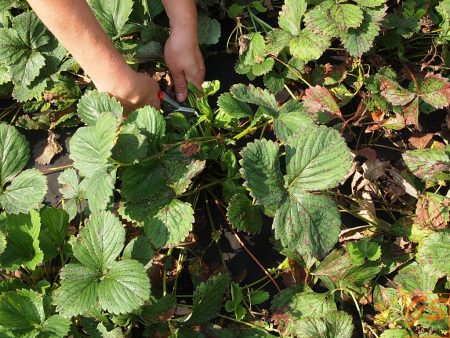
Growing strawberries is a complicated process only at first glance. For an excellent crop, simply follow these guidelines:
- landing should be carried out from May to early June or from the end of August to mid-September;
- for propagation, the first antennae from the mother bush are best suited, all others must be removed;
- Strawberry processing is carried out exclusively before flowering, and then after fruiting;
- all work with strawberries should be carried out either in the early morning or after sunset;
- pruning of leaves and removal of antennae should be carried out only with sharp scissors or secateurs;
- all tools must be disinfected before work in a solution of manganese;
- beds need to be mixed with compost at least once a year, it is also advisable to fertilize manure to maintain the nutritional composition of the soil;
- it is important to maintain soil moisture and carry out its regular loosening;
- for the winter, the bushes should provide adequate shelter.
Trimming the antennae and leaves of strawberries is one of the most important berry planting care points. Carry out the procedure in a timely manner, do not forget to water and feed the beds so that the crop becomes more abundant from year to year, and the berries are tastier.

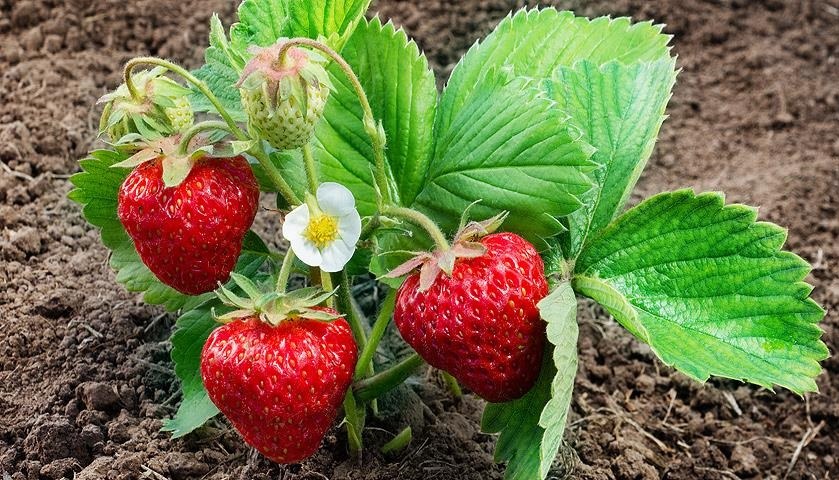
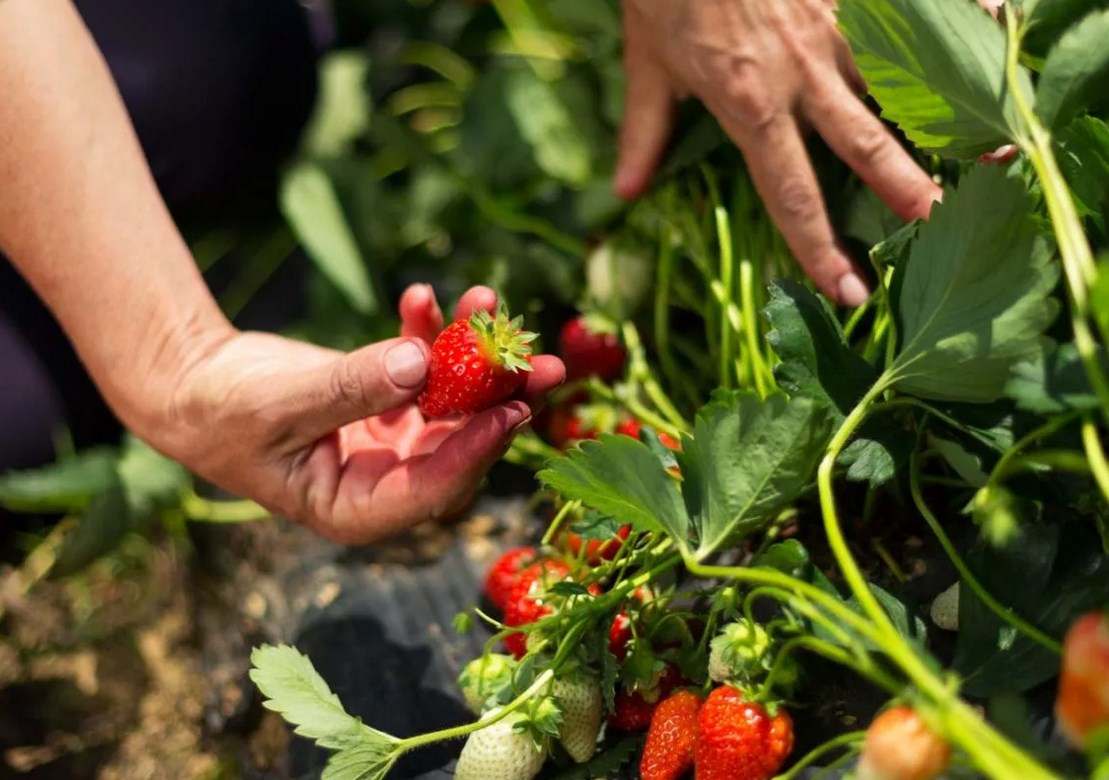
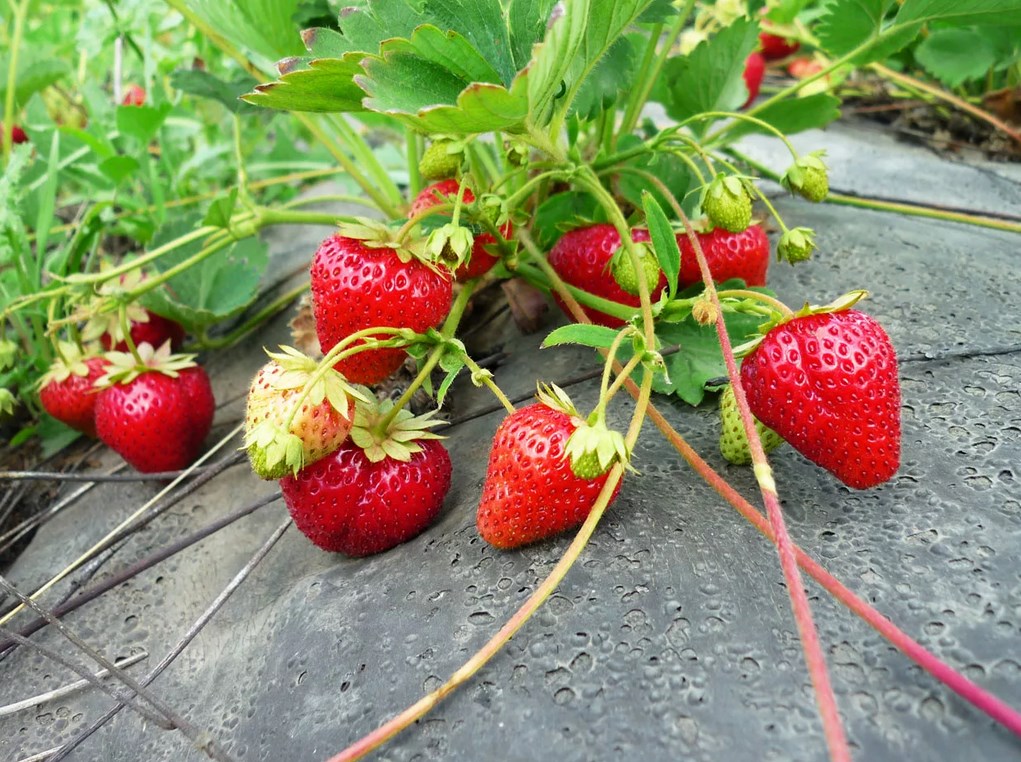
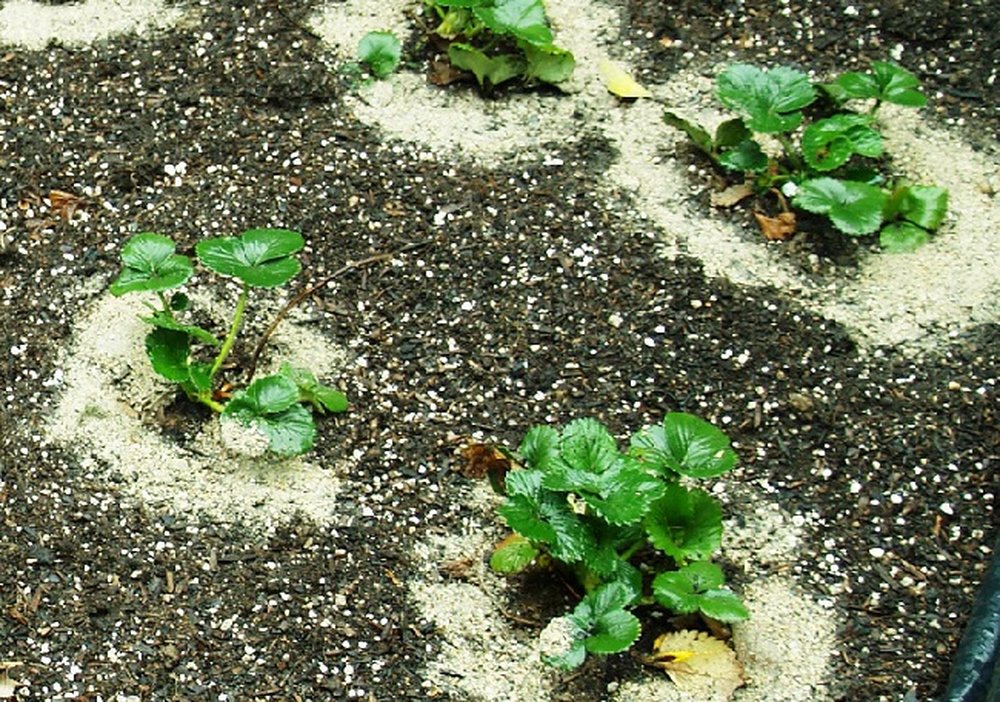 When to plant strawberries for seedlings from seeds in 2024
When to plant strawberries for seedlings from seeds in 2024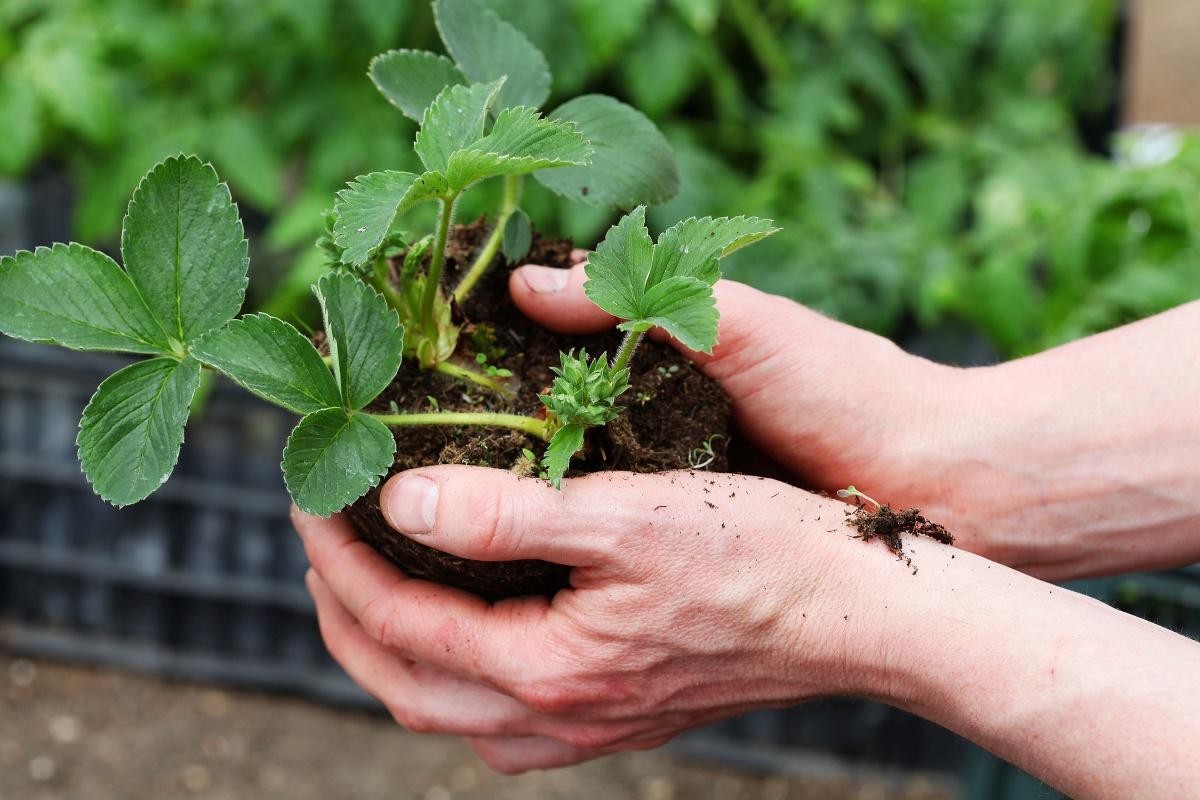 What month is better to choose for a strawberry transplant in autumn
What month is better to choose for a strawberry transplant in autumn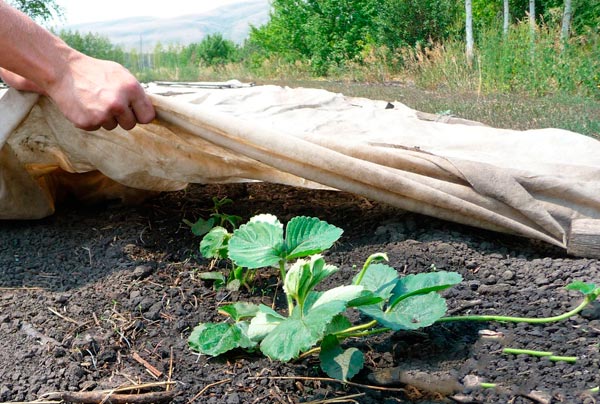 How to cover strawberries for the winter
How to cover strawberries for the winter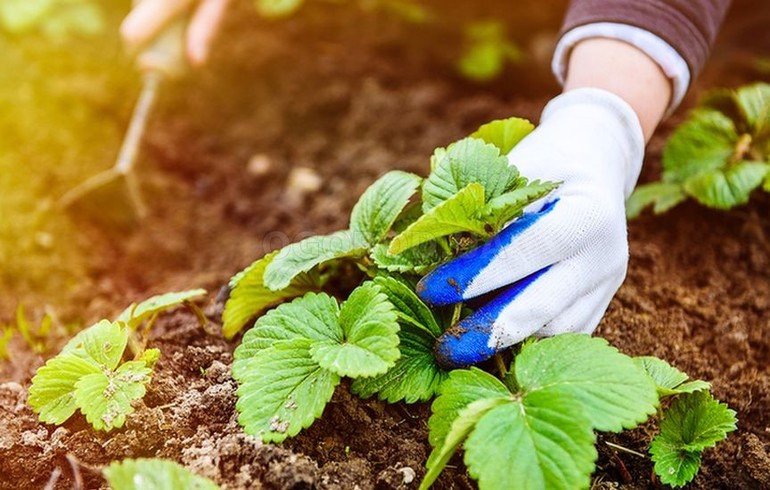 Proper care and pruning strawberries in the fall in the suburbs
Proper care and pruning strawberries in the fall in the suburbs